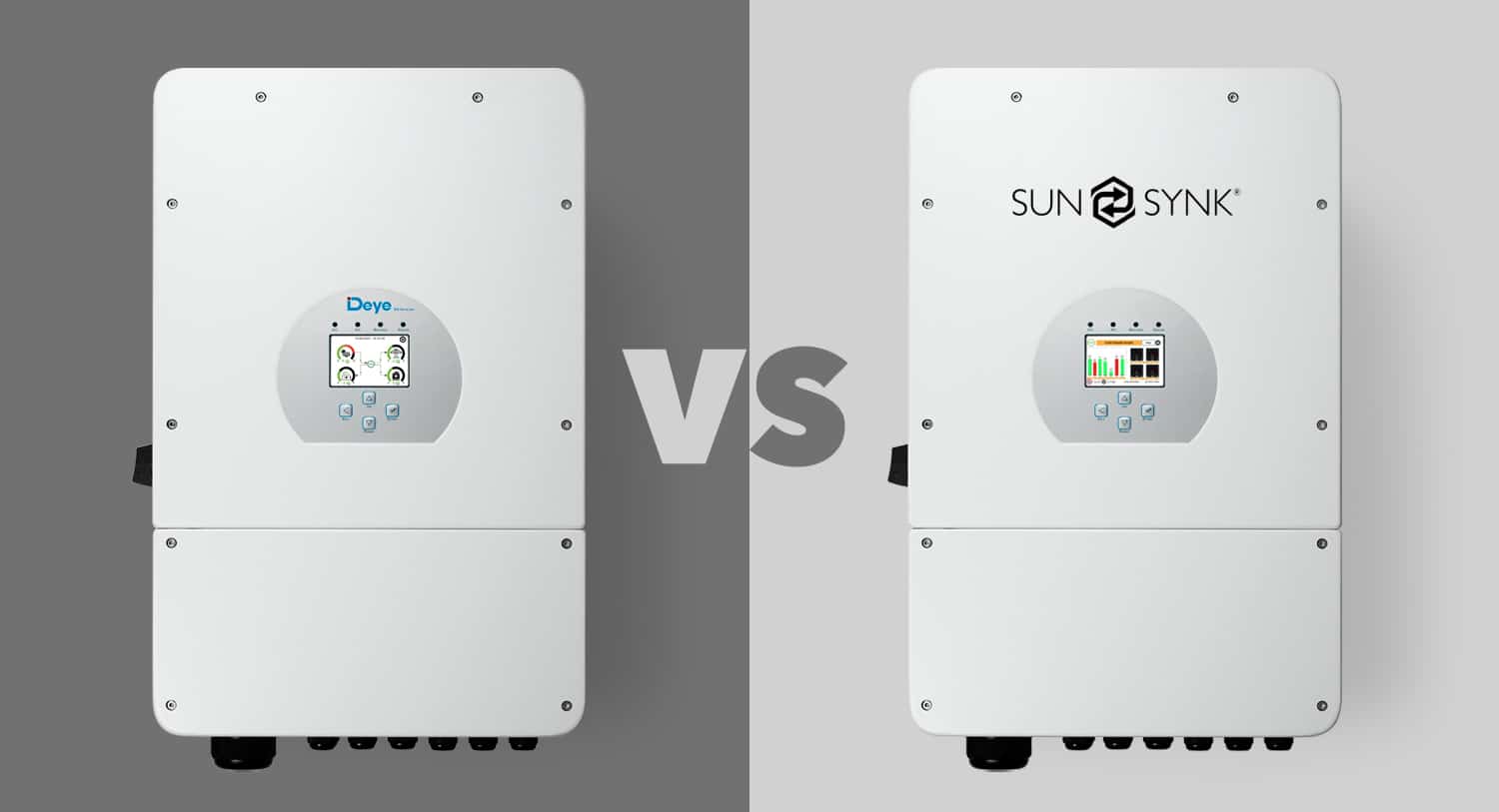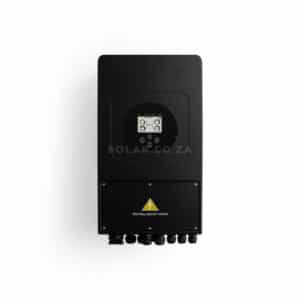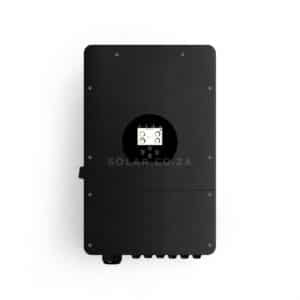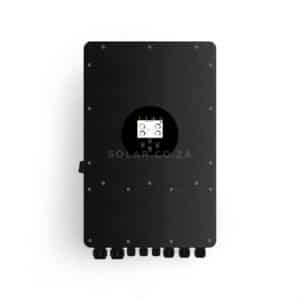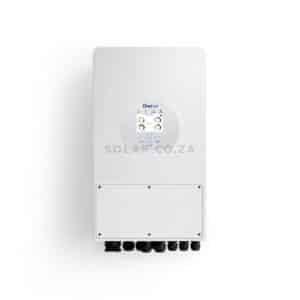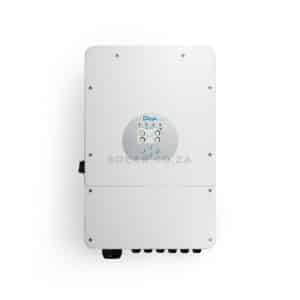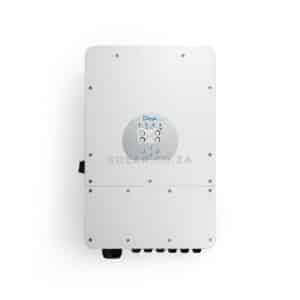In this Inverter Comparison guide, we’ll compare the Deye Inverter and the SunSynk Inverter. Because they are so alike, we’ll discuss their similarities and differences in their functionality, user interface and available apps.
Undoubtedly, the Deye Inverter & SunSynk Inverters are among the most popular solar power inverter brands in South Africa. They have both received excellent reviews from both consumers and installers alike.
They look similar and have similar specifications, so what is the difference between two?
Chapter 1
Inverter Comparison: Manufacturers
Who Manufactures Deye, Fusion & SunSynk Inverters?
Ningbo Deye Inverter Technology Co., Ltd. (Deye) manufactures the SunSynk Inverters, hence the likeness in appearance and the inverters’ near identical parameters.
Similarly, you may have seen the black Fusion Hybrid Inverters in circulation, which are rebranded Deye inverters.
When it comes to Deye/Fusion vs SunSynk, there is a slight difference between them in terms of their parameters, but the main differences are in the user interface & software.

Chapter 2
Inverter Comparison: Parameters
Deye Inverter Datasheet

SunSynk Inverter Datasheet

Inverter Comparison |
|||
|---|---|---|---|
| 5kW Deye Inverter Model: 5k-SG01LP1 | 5kW SunSynk Inverter Model: 5k-SG01LP1 | ||
| Battery Input Data | |||
| Battery Voltage: | 40-60V | Battery Voltage: | 40-60V |
| Max Charge & Discharge Current: | 120A | Max Charge & Discharge Current: | 120A |
| DC Input Data | |||
|---|---|---|---|
| Max DC Input Power: | 6500W | Max DC Input Power: | 6500W |
| MPPT Range (V): | 125-425V | MPPT Range (V): | 150-425V |
| PV Input Current (A): | 13A+13A | PV Input Current (A): | 13A+13A |
| Number of MPPTs: | 2 | Number of MPPTs: | 2 |
| AC Output Data | |||
|---|---|---|---|
| Rated AC Output Power: | 5000W | Rated AC Output Power: | 5500W |
| Max AC Output Power: | 5500W | Max AC Output Power: | 5500W |
| Peak Output Power: | 1000W for 10 seconds | Peak Output Power: | 1000W for 10 seconds |
| AC Output Rated Current (A): | 21.7A | AC Output Rated Current (A): | 22.7A |
| Power Factor: | 0.8 leading to 0.8 lagging | Power Factor: | 0.95 leading to 0.95 lagging |
Chapter 3
Inverter Comparison: User Interface
So the real difference between the Deye/Fusion and Sunsynk brands lies within the user interface. While they look very different, you can still access the same settings.
To illustrate the differences in their user interface, let’s compare their homes screens.

Deye’s home screen is straightforward and easy to understand. It displays your load, solar power production and usage, battery charge and discharge and grid consumption.
Additionally, you have access to the settings menu via the cog on the top right of the screen, and it shows you the date and time. When your system functions correctly, the centre will display “ON”, but if there is a fault, that code will be shown there instead.

SunSynk’s home screen is a little more complex. For example, it shows you your solar power production and usage, battery charge and discharge and your grid consumption in graph format.
You can also access the basic menu items on the right by tapping the cog button on the top right. You also have your name, date, time and serial number of the inverter. The fault code is also displayed on the screen if any faults occur.
Chapter 4
Inverter Comparison: Wifi Connectivity
Solar Man App
Solar Man is a downloadable app available for both iOS and Android users. It provides detailed historic data, is completely free to download and access and has an easy to use battery reserve function.
It does not provide real-time data.
SolarAssistant
SolarAssistant does not have an app. However, you can create an account with them and save a short cut your home screen account on your phone’s screen. The account is entirely free to use, with detailed real-time and historic data available, but there is a once-off cost for the device needed to connect your inverter to SolarAssistant. You can easily reserve your battery bank remotely too.
SunSynk Connect
SunSynk’s Connect App is very similar to Solar Man and SolarAssistant. It provides real-time and historic data access, and you can remotely access settings via the app.
The app is free to download and use for both iOS and Android users.
Chapter 5
Inverter Comparison: Prices

5kW Hybrid Inverter: R 17,233.90
8kW Hybrid Inverter: R 28,768.40
12kW (3-Phase) Hybrid Inverter: R 41,705.90

5kW Hybrid Inverter: R 28,855.80
8kW Hybrid Inverter: R 46,395.60
12kW (3-Phase) Hybrid Inverter: R 67,758.00
Solar Inverters For Sale
-
Fusion Inverters, Hybrid Inverters, Solar Inverters, Solar Power Products
Original price was: R21,275.00.R17,641.00Current price is: R17,641.00. inc VAT Read more -
Fusion Inverters, Hybrid Inverters, Solar Inverters, Solar Power Products
Original price was: R36,538.95.R31,482.40Current price is: R31,482.40. inc VAT Read more -
3 Phase, Fusion Inverters, Hybrid Inverters, Solar Inverters, Solar Power Products
Original price was: R52,325.00.R45,730.90Current price is: R45,730.90. inc VAT Read more -
Solar Power Products, Solar Inverters, Hybrid Inverters, Deye Inverters
Original price was: R18,248.20.R17,233.90Current price is: R17,233.90. inc VAT Add to cart -
Solar Power Products, Solar Inverters, Hybrid Inverters, Deye Inverters
Original price was: R31,482.40.R28,768.40Current price is: R28,768.40. inc VAT Add to cart -
Solar Power Products, Solar Inverters, Hybrid Inverters, Deye Inverters, 3 Phase
Original price was: R45,730.90.R41,705.90Current price is: R41,705.90. inc VAT Add to cart
Chapter 6
Conclusion
Both brands offer quality products with a built-in BMS (Battery Management System) that acts as a battery charger and controls your Li-ion batteries (lithium-ion) solar battery’s charge and discharge rates. They also include a solar charge controller.
They both have anti-islanding protection, which is especially important when you are grid-tied and feedback to the grid. You are also able to connect an alternative source of power, like a wind turbine or generator, for backup, although, this is quite a complicated task. They also have a maximum efficiency of 97.6%.
However, if the interface and software are a deal breaker, then SunSynk Inverter is for you.
On the other hand, since the cost of Deye’s products plus the device needed for SolarAssistant is nearly the same as that of SunSynk’s products. As a result, the bigger the size of the inverter, the more money you save. In addition to this, the Solar Man app includes remote battery settings, thus making the Deye Inverter a more affordable choice. So if you want to save some extra money for a nearly identical product, Deye is the perfect option.
If you’re unsure about the Deye or SunSynk options, I hope this Inverter Comparison guide has shed some light on which brand better suits your needs.
Tips on Choosing a Solar Inverter for Home & Businesses
Adding Solar Later
Remember that when you install an inverter battery system as backup for load shedding if you want to add solar panels later, it is vitally important that you choose a hybrid system.
Not only do they blend power sources, but they are capable of charging your batteries while providing precious solar power for you to utilise during the day.
Their blending capabilities will ensure you never waste any freely produced solar power.
Learn more about how Hybrid Inverters work by reading our guide.
Solar Systems are Expandable
You are never restricted to a specific solar system setup.
Depending on your chosen equipment, you can add to your system as your needs change. Adding more solar panels or batteries, later on, is quite simple and a great way to stagger the costs of your solar system.
Knowing your consumption and power needs is the first step in building a solar solution that will be enough for you now, but you have options to grow in the future.
Learn more about sizing up a Solar System by reading our guide.
Be Energy Smart
Being mindful of what appliances you are running and when you are running them will help you better understand your Solar Power System and how you can make your system more efficient. You can read the article if you want to learn more about how my family became energy independent by changing our consumption.
